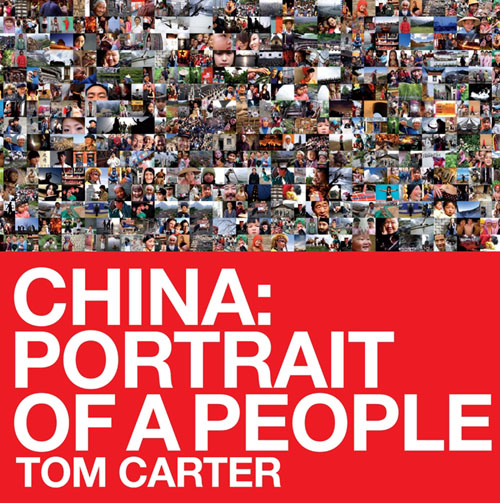Snapshot of a country
一個美國攝影師鏡頭下的中國
|
|
By John Sexton
China.org.cn staff reporter

|
| Like countless other young people, Tom Carter came to China to teach English and go traveling. But he traveled further, for longer, visiting all 33 of China's provinces twice in two years. He took more pictures than most. Crucially, he took the pictures that everyone else wanted to. |
像其他無數(shù)年輕人一樣,湯姆·卡特在中國教授英語的同時游遍大江南北。但是他比一般人旅行地更為深入和持久,他在兩年的時間內(nèi)兩次走遍中國33個省市。他拍攝了許許多多多的照片。關(guān)鍵的是,他拍攝了每個人都想拍攝的照片。 |
| The result, his book China: Portrait of a People, is a snapshot of an entire country in a time of great change; a truthful and touching portrayal of the Chinese people in all their variety, charm and earthiness. As such, even if it does not turn out a best-seller, it will have lasting value as a social document. This isn't a coffee table book of the Great Wall or the quintessentially Chinese landscapes of Guilin. It isn't a travel book either, although it may well inspire many to come see China for themselves. |
旅行的成果便是他出版了一本攝影畫冊《中國:一個民族的畫像》,拍攝下處于巨變時代中的中國,忠實而感人地記錄了中國人民的多彩風(fēng)姿、無窮魅力和質(zhì)樸純真。嚴(yán)格說來,盡管這本攝影畫冊不能成為一本暢銷書,但它作為社會的記錄具有持久的價值。它不是關(guān)于長城或典型的桂林風(fēng)景的休閑讀物,也不是旅游指南,但是它完全可以引發(fā)人們親自來到中國看一看的興趣。 |
| What's more, Carter has shown us just how easy it is. Just get on the bus, Gus. Buy a ticket, ride from town to town, chat to people and take their picture. I have traveled many of same roads in the same way and this photo-book captures the feel, the color, the smell of China better than most others I have seen. |
此外,卡特向我們展示了在中國旅游是如此簡單。只要坐上一輛公交車,買一張票,穿梭于各個城市之間,與當(dāng)?shù)厝私徽劊o他們拍照。我曾經(jīng)用同樣的方式游覽過許多同樣的地方,這本圖冊比我所見過的其他同類書籍能夠更好地捕捉到屬于中國的感覺、色彩和氣息。 |
| His subjects are casual, un-posed, unrehearsed. He manages to achieve an extraordinary intimacy, not just with cute kids and young women, but with worshippers at a mosque, with a miner caked in coal dust changing his clothes at the end of a shift. He clearly must have considerable charm to have achieved these candid snaps of people who are normally shy of having their picture taken. But as he says, and people who travel the country soon find out, ordinary Chinese people are extraordinarily warm with foreigners. |
他的拍攝主題隨意而不做作,也不做任何預(yù)先計劃。不論是和可愛的孩子還是年輕的女士,不論是和清真寺的禱告者還是輪班前更換衣服的滿身礦灰的礦工,卡特在拍攝照片時都能夠和他們形成一種舒適的默契。顯然,他必須具有很大的親和力才能為那些通常因為害羞而不愿拍照的人拍攝照片。但是據(jù)他自己所說,在中國旅游的外國人很快會發(fā)現(xiàn),這里的普通老百姓對外國人特別熱情。 |
| Above all, Carter's photographs depict the diversity of China, from chic young socialites to toothless derelicts, from wrestlers to karaoke girls. An let's not forget that this is a country of 56 official nationalities (and several more that, back in the 1950s, failed to make their case to officials overwhelmed with applications for recognition); Carter captures them, not dressed up for tourists, but still, in surprising numbers, wearing traditional dress. |
最重要的是,卡特的照片描述了中國的多樣性,從時髦而年輕的社會名流到?jīng)]有牙齒的流浪漢,從摔跤手到歌廳女郎。我們不要忘記這是一個由56個民族組成的國家 (比56個還要多,早在上世紀(jì)50年代,有幾個少數(shù)民族沒能向政府機構(gòu)申請獲得認(rèn)可),卡特拍攝的不是為了游客而身著盛裝的少數(shù)民族,而是許許多多穿著傳統(tǒng)服飾的少數(shù)民族。 |
| As Carter put it, during his two years on the road, his camera became an extension of his hand. And it is such a small, insignificant machine – not a digital SLR of the sort used by professionals. Why would he need one of those? These are not arty photographs. For the most part they are the sorts of snaps you could find in a family album. But this is the family album of a nation, the largest on earth. |
正如卡特所說的,在旅行途中的兩年時間里,相機成為他雙手的延伸。他使用的是一個小巧普通的照相機,并不是專業(yè)人士所用的單反相機。他覺得不需要用那樣的相機來拍攝,因為他拍的不是藝術(shù)照。他拍的大部分照片是你能夠在一本家庭相冊中找到的那種照片,只不過他拍的是一個國家的家庭相冊,恐怕是地球上最大的家庭相冊了。
|
|
|
|
|

